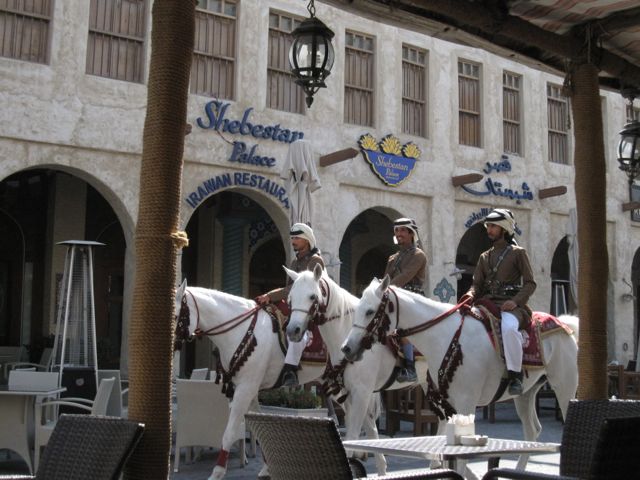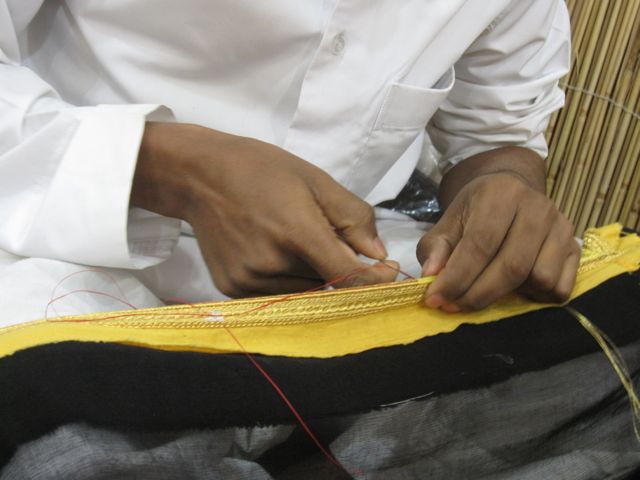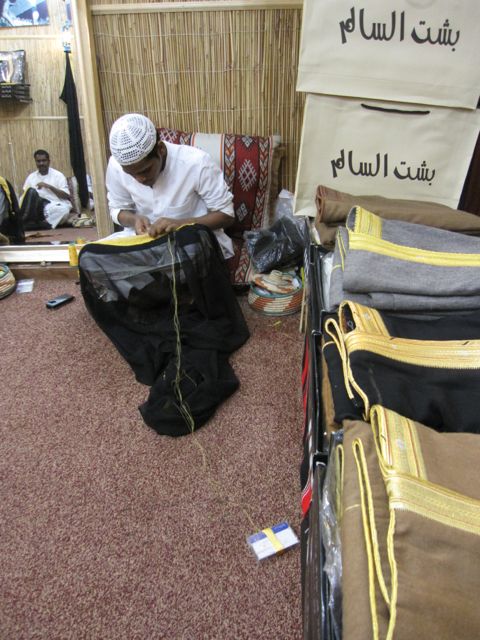Spinning with a different handmade spindle - made by Janet and modified by me. Using a new bowl from my friend Cathy Broski's kiln. Her jewel bowls are excellent for supported spinning.
a handmade tool
Well, I finished this at about the same time as finishing my Master's thesis, and I don't know which one I'm more proud and excited about.
It actually spins, which is amazing to me because halfway through this process it was just going blup....blup... in a lopsided manner, and I picked up one of my Ladakhi spindles and just marveled at the speed and smoothness of the spin. I have a new appreciation for hand-carved spindles that spin well.
But as I said, this one does spin, and the yarn I'm making with it proves its success as a tool. It's definitely not the most beautiful spindle, and mistakes were made, but for the first time I've turned a stick into a spindle with my pocket knife, and that speaks of promise!
The pith is showing in the photos, and it's on the side like that because this stick was slightly curved. I wasn't sure if I'd be able to get a straight, balanced spindle out of it, but my whittling mentor David Gowman said it was possible: I just needed to 'find the straight line.' This is why it was lopsided for a long time - I was reluctant to remove too much of the bulge, because I like phang-shaped spindles that have wide, substantial swells to them. But on the bulky side, more had to come off to allow for the spin.
This one wee project taught me so much, and I see my Ladakhi spindles and those made by my friend Janet completely differently now. I'm wishing for more willow sticks.
something else
Another beautiful thing going on.
A piece of willow, carved with a knife. Not very well, but as a process of discovery and growing understanding. The crisp facets of the wood, in its creamy whiteness, are mesmerizing.
Somehow this will be a spindle.
briefly
Sometimes the simplest thing I'm doing seems so beautiful.
I hope to expand these parts of my life, this way of being.
(It's a sweater I'm knitting with Berocco Remix yarn - recycled linen, cotton, acrylic & silk, and needles I made from sticks.)
Jordan textile conference
There were many beautiful and impressive things about the Traditional Textile Craft: An Intangible Heritage conference in Amman in April, 2014. But the most beautiful and impressive were the various women who are dedicating themselves to textiles through research, preservation, support of craftspeople, and the pure enthusiasm and love that goes along with such work.
We were very fortunate to be able to visit Widad Kawar's costume and textile collection at the new home she has created, called Tiraz: a home for Arab dress. Even more fortunate was her participation in the conference, her invaluable presence in this group of textile scholars and enthusiasts. She gave one of the opening talks, in which she explained that she didn't start out intending to collect, but things started happening, and "the more things happened around me, the more I collected." Poignant words from a woman who grew up in Palestine.
Widad also emphasized the importance of documentation, that the collection must be accompanied by as much information as possible. In her case, she conducted extensive interviews with people who created and wore the types of garments in her collection, gathering stories and historical facts. The wealth of knowledge represented by her textiles is awe-inspiring, and international groups and students work with her to help register and retain this priceless store of culture.
Widad is a joy to be around, constantly discussing textile traditions and practices, and eagerly examining any new textile that comes her way, whether in the slide presentations of the conference or worn by the participants (all of whom were usually wearing something interesting and handmade.)
Widad Kawar explains the use of the hanging basket for storing embroidery in progress, showing a wooden bobbin with unspun silk threads from inside the basket.
Traditional gift from a woman to her betrothed: an embroidered pouch to keep his tobacco and rolling papers.
During our visit to Tiraz, we were also treated to the collection of Layla Pio, an Iraqi woman with deep knowledge of the textiles of her country. She gave us a tour through the examples she had on display, including the Samawah kilim she is showing here, a woolen twill weave with dense chain stitch embroidery. I see these in the souq in Doha often.
Another woman by the name of Laila Tyabji, resplendent each day in different hand-crafted saris, runs a wonderful organization known as Dastkar. She gave an inspiring talk about her work, illustrated with so many beautiful images from India that I wanted her to just keep talking and show them all slowly. Craftspeople in the most difficult of circumstances, but given strength by their skills and traditional knowledge. Laila noted that it was craftspeople who recovered more quickly, after the massive earthquake in Bhuj, than other livelihoods. She said that when the skills exist, it takes very little to revitalize a craft tradition, and she gave delightful examples of the ingenuity and creative involvement of the craftspeople, when they are given the chance to participate in the design. Her work carries so much insight into the process of supporting traditional craft, insight that she has developed through myriad ongoing interactions and observations of what is successful and what is not. Overall, her conclusions were quite encouraging and affirmed that the living tradition simply needs to be allowed to function, in the way the people have learned and taught for centuries, and that this can be a very resilient system that need not be threatened by modern consumerism.
Laila Tyabji blends in with the textile glory in a completely hand-embroidered sari.
Until I have time to write more, I include some more details of this over-saturated week.
Bedouin belt from Tiraz collection, card woven with twining, braided fringe.
More garden decor at Al Alaydi Jordan Craft Center.
Rich detail of a Palestinian dress, with Syrian silk fabric appliqué.
Metal thread embroidery detail on a Syrian silk abaya from the 19th century, at Tiraz.
sewing bhisht
Sometimes I forget that I live in an exotic place, to the sensibilities of people back home. A trip to the souq usually corrects that lapse. Even on a normal day, Souq Waqif smells of spices and incense, and teems with shopping Qataris, groups of small schoolchildren, the odd tourists, and of course the mounted traditional patrol, above. They are, ostensibly, some kind of security force, but really it's for show.
I was determined to find the 'handicraft section' of the souq, since I'd heard about it from people who moved here recently. The reason I hadn't known of it before was probably because it didn't exist. Anyway, entering the alley helpfully labeled "Handicraft Market", I found some guys working with their hands. This is a bhisht shop.
A bhisht is a traditional robe Gulf Arab men wear over their white thobe. They used to be made from handspun camel hair, and some of them probably still are. This one appears to be wool, and is a dense, warp-faced weave, as opposed to the more open, sheer plainweave often seen in diplomats' and political leaders' bhisht.
Gulf Arab leaders in typical dress (former Emir of Qatar, second from left, in the most sheer bhisht - a sign of status?)
While I've taken an interest in the wool of the robe, the metallic thread embroidery is so dense and shiny, I always kind of assumed it was made by machine. But these guys in the souq showed me how wrong I was. There they sat, earbuds in, fingers flying across the fabric stretched between their knees.
Some of them were couching the gold threads with another thread, as above, and others were actually making stitches with the gold. The bobbin of choice for metal threads is a cassette tape cover. I imagine them salvaging the tape boxes long after they have discarded the tapes in favor of their MP3 or iPod.
Given that this was an entirely male, Muslim space, I was timid with the photographs, and didn't get right up in their work to see the details of the stitching. But an examination of the finished pieces shows an impressive array of stitches and patterns, and I gained a new appreciation for this traditional garment.
The little spots of silver look almost random.
spinning and more spinning
There are many spindles in action at the moment.
I've just started spinning a batt made by the young daughter of wooldancer. I had the good fortune to visit Michelle's studio in the Blue Mountains... was it really 3 years ago? As we talked fiber and yarn, her daughter gathered supplies and drum-carded a gift batt for me.
I've paired the sparkly, fairy magic batt with a spindle made by Devrim in Turkey. Makes for a great portable project.
This yarn is one element of my fourth Revolution yarn. The challenge is called Revolution 5 (Ravelry link), and we spin a yarn from multiple ingredients, then use the leftover fibers from that one as the base for the next yarn. They become a stream of consciousness, feeding into each other and subtly related.
The previous ones:
Revolution 1
Revolution 2 in progress
Revolution 2
Revolution 3 on the bobbin
Revolution 3
Realizing that I had spun a singles, a two ply, and a chain or 3 ply for Revolution 1, 2 and 3, I decided that the fourth must be a four ply, or a cabled yarn (two 2 plies, plied together.) Then of course a five ply for the last one.
Don't hold your breath. This has been a long, slow process, and shows no signs of speeding up. I wonder if it will take me a whole year....
Spinning a 3-year-old batt, in a months-long project of five spins. This is an art not to be rushed. One of my favorite things about spinning yarn is that it accompanies me through life, taking place over time, absorbing and reflecting the moments during which it is created.
sewing boats
That's right, these boats are stitched. This detail shows some rusty nails and plastic string, but traditionally they're entirely done up with coir, coconut fiber, which expands to fill the gaps in the wood but doesn't let water through.
I saw a lot of these stitched hulls in Kerala, when we spent a week in Aleppy, the 'backwater' town full of canals and waterways. It's wonderful to see everyone going about in boats. Boats with this construction are used for everything from minimal one-person vessels to cargo barges.
I was even told that the massive houseboats are made this way. While I'm not sure the hulls are still stitched, there is certainly a lot of handiwork in the beautiful boats.
At the third annual Dhow Festival in Doha last weekend, I got a chance to see the work in action. Two men were stitching a boat on the beach, with another man giving explanations and answering questions.
The men pass the rope through drilled holes, and it secures a bundle of coir fibers and a layer of rope on the inside. They use spikes, chisels and wooden dowels to tighten the stitches, levering the tools against each other.
I didn't manage to fully grasp the process or retain the Malayalam words for this art, but it was a treat to see the work in progress, after admiring not only the boats in Kerala but also the ones owned by the Qatar Museum Authority.
inaugural post
Welcome to the celebration













